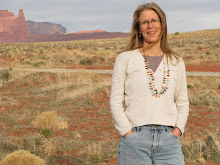 I'll admit it right up front: I love Christmas. Not for the piles of presents—I like receiving gifts as much as anyone else, but honestly, what I love about this holiday of lights is not the accumulation of more stuff.
I'll admit it right up front: I love Christmas. Not for the piles of presents—I like receiving gifts as much as anyone else, but honestly, what I love about this holiday of lights is not the accumulation of more stuff.Nor do I love the commercial-ization of what once was an especially spiritual and giving time of year but has now become the season of shopping, during which every advertisement encourages us to buy, buy, buy.
No, what I love about this winter holiday is its green and joyous roots, which come through no matter how over-commercialized, over-consumptive, and simply stressful Christmas has become.
I love the lights, the joyful music, the spicy smell of sap from evergreen trees and wreaths, the opportunity to practice generosity and the warmth of fellowship, and the quiet time to reflect on the year soon ending.
The holiday that we call Christmas began for all that. Long before Black Friday and super-special discounts that encourage mob behavior, Christmas was a celebration of light and the miracle of renewed life in the darkest, coldest days of winter.
In those days before central heating guaranteed warmth and electricity stretched daytime deep into winter's nights, and before the technology of fossil fuels transported people and goods from continent to continent, winter was a season that took concerted effort to survive.
When the solstice came and the sun rose and set far to the south, appearing to hesitate before finally, gradually turning back toward longer days and shorter nights, celebration was most definitely in order.
Hence the lights, including the tradition of the Yule log, a massive log that would burn through hours of darkness, and the Hannukkah candles, symbols of survival through the most difficult of times.
And the evergreens, brought inside as reminders that life continues even when the soil itself freezes and snow mantles the earth. The music and feasting to warm bodies and lift spirits depressed by the cold and lack of daylight.
And just as important, the stories told specially for this time of year to remind us that even when times seem bleak as the weather, we are capable of miracles as bright and promising as the shimmering stars that guide us, tales that hold out hope that our best selves will lead us into a new year and new life.
If you look past the advertising, the sales, the exhortations to buy more and bigger and fancier stuff, Christmas is still there.
It's in the unexpected and genuine smiles, the sound of voices raised in joyful song, the heartfelt giving of gifts, the acts of sudden generosity like shoveling someone else's sidewalk, the invitations to gather over festive food and drink, the moments of quiet when we remember why we are here, and the lights, both those twinkling from houses and the eternal, ever-changing show in the heavens overhead.
It's in the darkness and the blessing of dawn, but most of all, Christmas is the spirit that burns within us all, every day.
This post comes from my weekly newspaper and radio commentary, which is also available in audio version as a podcast on my web site, susanjtweit.com.
I'm taking next week off for the holidays, and will return to blogging early in the new year, with some changes and some great news. May the new year bring you all a richer connection to your community, and great joy! Blessings, Susan















